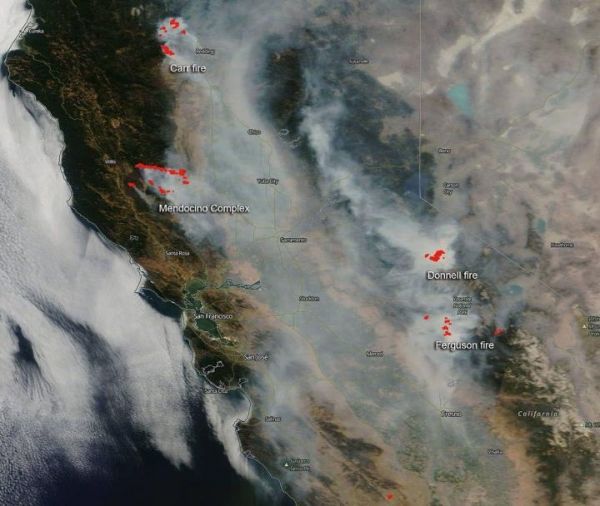Against a backdrop of long-term rises in temperature in recent decades, California has seen ever higher spikes in seasonal wildfires, and, in the last two years, a string of disastrous, record-setting blazes. This has led scientists, politicians and media to ponder: what role might warming climate be playing here? A new study combs through the many factors that can promote wildfire, and concludes that in many, though not all, cases, warming climate is the decisive driver. The study finds in particular that the huge summer forest fires that have raked the North Coast and Sierra Nevada regions recently have a strong connection to arid ground conditions brought on by increasing heat. It suggests that wildfires could grow exponentially in the next 40 years, as temperatures continue to rise.
The study notes that average summer temperatures in the state have risen 3.25 degrees Fahrenheit since 1896, with three-quarters of that increase occurring since the early 1970s. From 1972 to 2018, the area burned annually has shot up fivefold, fueled mainly by a more than eightfold spike in summer forest fires. The researchers say the summer forest-fire increases are driven by a simple mechanism: when air heats up even modestly, it causes more moisture to evaporate from soils and vegetation. The result: fires start more easily, and can spread faster and farther. During the fall, and in non-forested areas, different dynamics may be at work and the results are less clear; but the researchers project that climate-driven aridity is likely to play a growing role there as well.
“It’s not a surprise to see that climate has this effect in forests, but California is so big and so variable, there is no one-size-fits-all explanation for how climate might affect wildfires across the board,” said the study’s lead author, Park Williams, a bioclimatologist at Columbia University’s Lamont-Doherty Earth Observatory. “We have tried to provide one-stop shopping to show people how climate has or, in some cases, hasn’t affected fire activity.” Williams and his colleagues have already shown in a 2016 study that heightened temperatures and resulting aridity on the ground has doubled the area burned in forest fires over wider areas of the U.S. West in past decades. The new study appears in the journal Earth’s Future.
Read more at: Earth Institute at Columbia University
A satellite image, August 6, 2018, shows smoke from multiple large California wildfires. The fires themselves, detected by thermal imagery, are in red. (Photo Credit: NASA)


